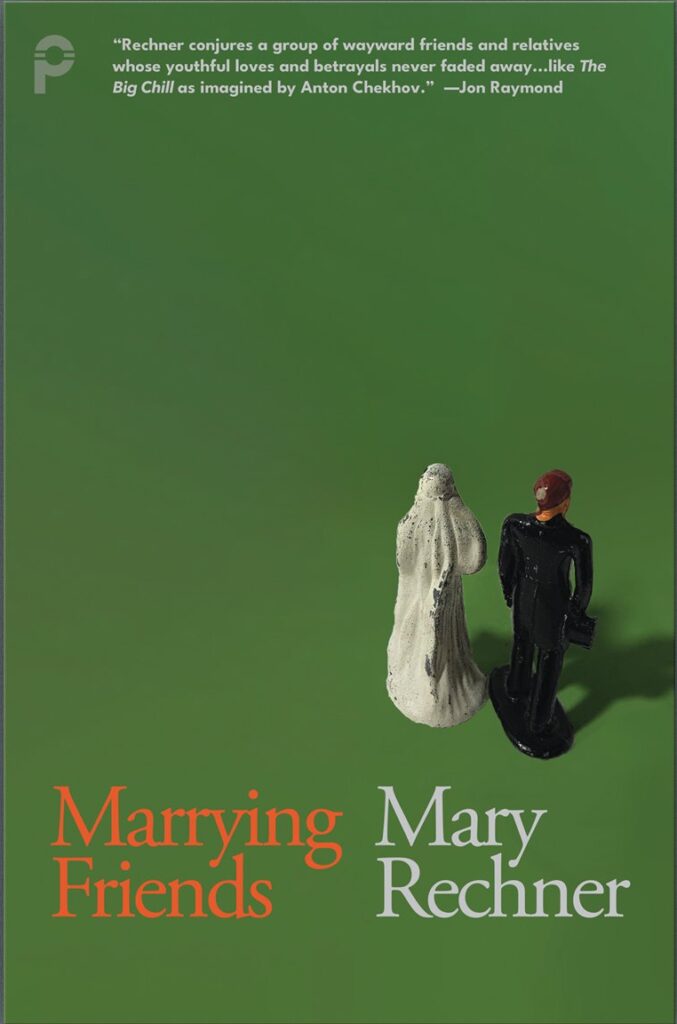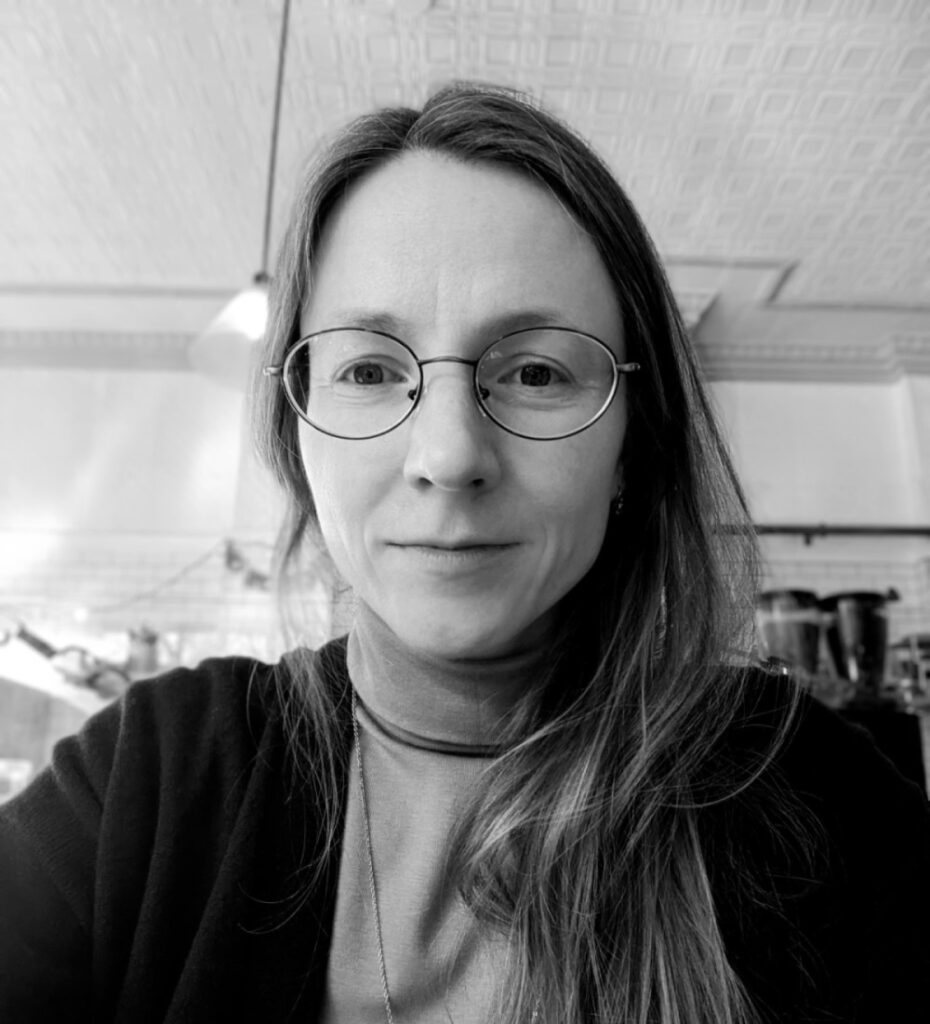A Review of Mary Rechner’s Marrying Friends
By Olga Katsovskiy
Mary Rechner’s Marrying Friends novel-in-stories invites the reader into the intimate lives of two sisters, whose friends and dysfunctional families come together at a funeral and a wedding – where time stands still. Unlike her debut short story collection, Nine Simple Patterns for Complicated Women, where a group of virtuous women struggle to cope with motherhood and their ungrateful spouses, Marrying Friends brings the flaws of both sexes to the table.
The story begins with Lisa, a single woman who finds solace and artistic freedom living alone in the desolate woods of Vermont. Viewed as the family spinster, Lisa has no interest in keeping in touch with her disapproving parents and sister Therese. However, after Therese is widowed, Lisa is compelled to return to Long Island to attend Mark’s funeral. Rechner challenges conventional relationships between men and women, focusing on the unspoken dark side of compromise.
Mark’s death catapults the characters into examining their individual shame, and the institutions keeping it at bay. We follow the stories of a close-knit group of friends: Joanna and her brother Jude, Kevin, and Mark, who have all known each other since they were teens. All of them struggle with impulsivity, whether it be drugs, sex, alcohol, or candy. They want it all and they want it NOW. Mark’s parents, Adam and Miriam, and their in-laws, Paul and Alice, represent conventional marriages grounded in self-sacrifice and devotion – something the new generation desperately wants to avoid.
Adam disapproved of Mark’s friendships, particularly with Jude, who “had always struck Adam as low achieving and manipulative” (p. 112). Consequently, Mark’s teenage years were rough, and he got in with a “bad” crowd. Adam blamed Miriam for spoiling their son. He put his foot down when Mark went to college, coercing him to follow his footsteps to a career in banking. Mark never found his calling and rushed into marriage to escape. At his wake, everyone knows he died of a drug overdose but call it a stroke. We don’t know why Mark turned to drugs. Was it because he was unfulfilled at his job? His unfaithful wife? It could have been both or something digging deeper into his skin. Drugs gave him an instantaneous release from his dreadful reality.
With Therese, “there had always been other men […] Her affair with [Jude] ran alongside her marriage to Mark,” (p. 80) and went on after his death. Her character is wildly erotic, seduction being one of her strengths. “If Therese was unkind, she was also brave; she made other people seem tame” (p. 127), her mother Alice thinks to herself, judging Therese’s demeanor at a family gathering. Therese goes for sex without intimacy, chasing the “unconfined” (p. 83) rapture of the physical act, which inevitably leaves her emotionally starved for real connection.
Lisa’s sex life is mediocre and the closest she gets to real intimacy is via secret phone calls with Mark. She mourns him at the wake not only because they were friends too, but because she loved him. Lisa achieves intimacy without physical touch, but it isn’t enough. She is a recovering alcoholic, and of all the characters in this collection, the only one owning her vice and actively working on remaining sober. “Drinking helped her pause, relax, and take pleasure in what so often felt like sad, frightening, chaotic life. Liquor wasn’t in fact affirming, it was merely predictable” (p. 186). Her actions contrast sharply with Therese’s, who “thrived on chaos” (p. 179) and avoided predictability at all costs.
Joanna and her husband Sam move in with her parents, after an unsuccessful stint with their jobs and financial troubles. As the couple grows apart in the confines of their new living arrangement, Joanna tells him he must “become someone else, someone new” (p. 53) to adjust to their environment. Sam’s “sad habit” (p. 52) is porn, instant gratification, a distraction from his disappointments and disconnection with his wife. As Joanna adjusts and succeeds in her career, Sam “felt himself sinking” (p. 55). Instead of celebrating with his partner, he is jealous of her success.
What we see in the parents is the long-term effect of a lifetime of grudges. What Adam misses about being young are his emotions. “As he grew older, he learned how to even things out in order to sustain them, or survive them, but it also felt like everything got watered down” (p. 110). Likewise, Paul feels he “was banished from himself” (p. 131) in his marriage. But their wives, too, “carried secret hurts” (p. 191) and felt so lonely they sometimes wondered if they would be better off alone.
Sexual desire and its role in intimacy is quite prominent in this collection, being a primary drive for most of the characters. Rechner tastefully broaches the subject of sex and its ability to both deepen and shatter relationships. At an art reception Lisa thinks that everyone there is sizing each other up, “considering the possibility of cheating on their boyfriends or girlfriends, husbands or wives, of leaving their real lives temporarily behind” (p. 68). Throughout the book sex is portrayed as a means of escape. It makes life tolerable, but all the characters are living in denial, losing touch with their true passions and even themselves.
In one of the early chapters, Joanna confides a shameful secret to her mother who follows with, “Do you know […] there are worse things in the world than inappropriate sex?” (p. 25). The question looms over the course of the book. The way I see it, the worst thing in the world is feeling alone with the person lying next to you. Perhaps Lisa’s cozy A-frame in the woods doesn’t sound so bad after all.


Olga Katsovskiy
Olga Katsovskiy, writer/editor/educator, is a CNF Editor for Minerva Rising Press, Associate CNF Editor for JMWW, and CNF reader for Reckon Review. She works in a healthcare organization in Boston and is a writing instructor at the Cambridge Center for Adult Education. Her essays have been published in Atticus Review: The Attic, Barzakh Magazine, Brevity Blog, Gone Lawn Journal, Pithead Chapel, and elsewhere. Find more at theweightofaletter.com or theweightofaletter on Instagram.
